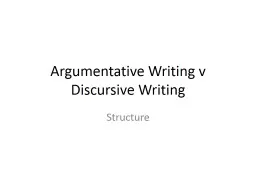

Structure Discursive Writing The structure of discursive essays is traditional You should remain impartial and look fairly at both sides of the situation Discursive Writing The introduction should not have an opinion nor suggest any conclusion ID: 595613
Download Presentation The PPT/PDF document "Argumentative Writing v Discursive Writi..." is the property of its rightful owner. Permission is granted to download and print the materials on this web site for personal, non-commercial use only, and to display it on your personal computer provided you do not modify the materials and that you retain all copyright notices contained in the materials. By downloading content from our website, you accept the terms of this agreement.
Slide1
Argumentative Writing v Discursive Writing
StructureSlide2
Discursive Writing
The structure of discursive essays is
traditional
.
You should remain
impartial
and look
fairly
at
both sides
of the situation.Slide3
Discursive Writing
The introduction should not have an opinion nor suggest any conclusion
There should be no personal pronouns in the introduction
The thesis statement (last sentence of introduction) will formally outline the aim of the essaySlide4
Discursive Writing structure
(based on the 5 paragraph model)
Introduction. The structure of discursive essays is
traditional
. You should remain
impartial
and look
fairly
at
both sides
of the situation.
The thesis statement appears here in the final sentence of the introduction and should be impartial (no bias).
Body paragraph 1. The body paragraphs should be balanced and fair (looking impartially at both sides of the subject). The body paragraphs should be balanced and fair (looking impartially at both sides of the subject). The body paragraphs should be balanced and fair (looking impartially at both sides of the subject). The body paragraphs should be balanced and fair (looking impartially at both sides of the subject)
Body paragraph 2. The body paragraphs should be balanced and fair (looking impartially at both sides of the subject). The body paragraphs should be balanced and fair (looking impartially at both sides of the subject). The body paragraphs should be balanced and fair (looking impartially at both sides of the subject). The body paragraphs should be balanced and fair (looking impartially at both sides of the subject)
Body paragraph 3. The body paragraphs should be balanced and fair (looking impartially at both sides of the subject). The body paragraphs should be balanced and fair (looking impartially at both sides of the subject). The body paragraphs should be balanced and fair (looking impartially at both sides of the subject). The body paragraphs should be balanced and fair (looking impartially at both sides of the subject)
Conclusion. The conclusion should summarise the key points from above and conclude based on the main points from above in a fair and impartial way. At this point it is acceptable to state an opinion (but based on the facts and not using the 1
st
person).Slide5
Argumentative Writing
The structure of argumentative essays is
non-traditional
You should not remain
impartial
and you should be biased to your opinionSlide6
Argumentative Writing
The introduction should have an opinion in the first paragraph (usually in the thesis statement)
There can be personal pronouns in the introduction (“I think that…”
The thesis statement (last sentence of introduction) will outline the aim of the essay but can be biasedSlide7
Argumentative Writing structure
(based on the 5 paragraph model)
Introduction. The structure of argumentative essays is
not
traditional
. You can be
biased
and be
unequal
when writing about a topic.
The thesis statement appears here in the final sentence of the introduction and should be biased to your opinion. It can contain personal pronouns
“I think that....”
Body paragraph 1. The body paragraphs should be un-balanced and only support your opinion (supporting only your argument). The body paragraphs should be un-balanced and only support your opinion (supporting only your argument). The body paragraphs should be un-balanced and only support your opinion (supporting only your argument).
Body paragraph 2. The body paragraphs should be un-balanced and only support your opinion (supporting only your argument). The body paragraphs should be un-balanced and only support your opinion (supporting only your argument). The body paragraphs should be un-balanced and only support your opinion (supporting only your argument).
Body paragraph 3. You can mention the other side of an argument ONLY if it supports your main argument (these are called
counter arguments
) in situations where you can not ignore something. For example if your essay is titled ‘Why smoking is healthy’ then you need to mention that some evidence suggests smoking can be unhealthy (because to ignore it would be to weaken your argument). E.g. “some people suggest smoking is unhealthy, however smoking helps people to relax and many people gain a lot of weight when they quit smoking, which is equally if not more unhealthy”
Conclusion. The conclusion should summarise the key points from above and conclude based on the main points from above in a biased way. Re-cap the original opinion from the introduction.